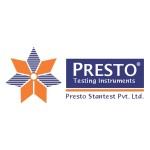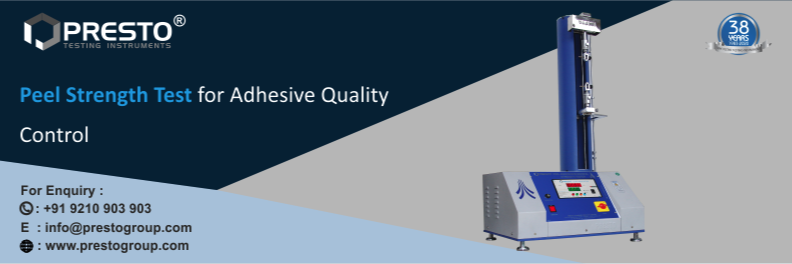In the world of manufacturing, ensuring the bond strength between materials is critical to maintaining product integrity. From packaging materials to adhesives, laminates, and films, manufacturers need to guarantee that their products hold together under various stresses. This is where a peel strength test comes into play. Using specialized equipment such as a peel tester machine or a peel bond strength tester, industries can evaluate how well materials are bonded and ensure that they meet required quality standards.
In this blog, we'll explore what the peel strength test is, why it's important, how a peel tester machine works, and its various applications across industries.
What is a Peel Strength Test?
A peel strength test measures the force required to separate two bonded materials. It is an essential quality control test that helps manufacturers determine the bond strength between adhesives, laminates, films, and other bonded materials. This test is particularly critical in industries such as packaging, automotive, electronics, and construction, where the durability and reliability of bonded materials are key to product performance.
The peel test evaluates how strong the adhesion is and whether it can withstand external forces like tension, pressure, or environmental changes. By understanding the peel strength, manufacturers can ensure that the materials won't come apart prematurely, which can result in product failure.
Why is Peel Strength Testing Important?
Peel strength testing is crucial for several reasons:
- Product Durability: Ensuring that materials stay bonded is essential for the durability and longevity of the product. For instance, packaging materials need to remain intact during transportation, and adhesives in construction must hold up over time.
- Safety and Reliability: In industries like automotive or electronics, weak bonding can lead to catastrophic failures. Peel strength testing ensures that critical components remain securely attached, ensuring safety and reliability.
- Quality Control: Peel strength tests are an integral part of quality control processes, helping manufacturers to detect defects in bonding at an early stage. By conducting these tests regularly, manufacturers can maintain consistent product quality and minimize costly recalls.
- Regulatory Compliance: Many industries require products to meet specific adhesive or bonding strength standards. Peel strength testing ensures compliance with these regulatory guidelines, reducing the risk of non-compliant products reaching the market.
How Does a Peel Tester Machine Work?
A peel tester machine is designed to measure the peel force required to separate two bonded materials. The machine works by applying a controlled force to the bonded surfaces and measuring the amount of force needed to break the bond.
Here’s a step-by-step breakdown of how the peel tester machine operates:
- Sample Preparation: The test begins with the preparation of a sample where two materials have been bonded together. This can be a laminate, adhesive strip, or packaging material.
- Mounting the Sample: The bonded sample is then mounted on the peel tester machine, which holds it securely in place.
- Applying Force: The machine applies a uniform force along the bonded surface at a set angle, typically 90 or 180 degrees, depending on the type of peel test being conducted.
- Measuring Peel Strength: As the force is applied, the machine measures the peel strength, which is the force required to separate the bonded materials. The results are recorded and used to assess the quality and strength of the adhesive or bond.
- Results and Analysis: The test results provide data on the force needed to peel the materials apart. Based on these results, manufacturers can determine whether the bond strength meets the required specifications or needs improvement.
Applications of Peel Strength Testing
Peel strength testing is widely used in various industries to ensure that bonded materials can withstand the forces they will experience in real-world conditions. Here are some key applications:
1. Packaging Industry
In the packaging industry, peel strength tests are crucial for assessing the bond strength of labels, seals, and laminates. Packages that don’t have strong seals can leak or become damaged during transportation, leading to product spoilage or contamination. Using a peel bond strength tester, manufacturers can ensure that packaging materials are securely sealed and durable.
2. Automotive Industry
Adhesives are commonly used in the automotive industry to bond components like interior panels, trim pieces, and exterior body parts. Peel strength tests ensure that these adhesives can hold up under the stress of everyday use and harsh environmental conditions. Testing the peel bond strength guarantees the reliability and safety of adhesive joints in vehicles.
3. Electronics Industry
In the electronics industry, peel strength testing is essential for evaluating the bond strength of adhesives used in devices like mobile phones, laptops, and other gadgets. These devices experience regular handling and pressure, so strong adhesive bonds are necessary to ensure their longevity and durability.
4. Construction Industry
Adhesives and sealants are widely used in the construction industry for bonding materials like flooring, tiles, insulation, and more. Peel strength tests help ensure that these materials remain securely bonded even in changing environmental conditions, such as temperature fluctuations or moisture exposure.
Benefits of Using a Peel Bond Strength Tester
A peel bond strength tester provides manufacturers with several advantages:
- Accurate Results: The tester offers precise measurements of the force required to separate bonded materials, ensuring that the bond strength meets specific requirements.
- Versatility: Peel bond strength testers are designed to work with a wide range of materials, including films, laminates, adhesives, and more.
- Improved Quality Control: Regular peel strength testing allows manufacturers to identify weak bonds early in the production process, ensuring that only high-quality products are released to the market.
- Cost Savings: By detecting bonding issues before products are distributed, manufacturers can save money on product recalls, repairs, and customer complaints.
Conclusion
A peel strength tester is a critical quality control tool used across various industries to assess the bonding strength between materials. With the help of a peel tester machine or peel bond strength tester, manufacturers can ensure that their products meet industry standards for durability, safety, and reliability. Whether in packaging, automotive, electronics, or construction, peel strength testing plays a key role in maintaining product integrity and ensuring customer satisfaction.






Comments